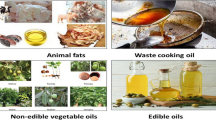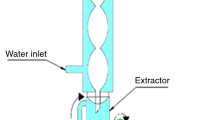Abstract
Green diesel, also known as renewable diesel, is a biofuel obtained from biomass with similar physical properties than petroleum diesel. Renewable diesel is mainly composed by hydrocarbons free of oxygen, which can be blended at high concentrations with petroleum diesel due to their chemical affinity. Density and viscosity are two important physical properties of fuels that play an important role in the processes of atomization and injection in engines. Also, the knowledge of these properties is important for the correct design, operation, and optimization of chemical processes. Despite their importance, there is low information about experimental data and developed models related to the renewable diesel–petroleum diesel blend. To overcome the above limitation, this paper is focused on the study of four blends of renewable diesel and petroleum diesel in order to study the variation of density and kinematic viscosity with respect to the concentration and temperature. In addition, empirical correlations to predict the density and kinematic viscosity as function of temperature and concentration were developed. Density and viscosity of renewable diesel, petroleum diesel, and their blends were simultaneously measured with a densitometer–viscometer device with an uncertainty in density and viscosity of 0.1 kg/m3 and 1 × 10−8 m2/s. The parameters of the developed correlations were adjusted by the Levenberg–Marquardt optimization method. There was a good agreement between the calculated and experimental data because an average absolute deviation (AAD) of 0.07 and 1.66% were obtained for the predictions of density and kinematic viscosity respectively.






Similar content being viewed by others
Abbreviations
- a, b, c, and d :
-
adjusted parameters
- AAD:
-
average absolute deviation
- ASTM:
-
American Society for Testing and Materials
- calc:
-
calculated values
- CO:
-
carbon monoxide
- CO2 :
-
carbon dioxide
- DO:
-
deoxygenation
- exp:
-
exponential function
- expt:
-
experimental values
- FAMEs:
-
fatty acid methyl esters
- FBP:
-
final boiling point
- GC-MS:
-
gas chromatography mass spectroscopy
- GHG:
-
greenhouse gas
- H2 :
-
hydrogen
- HC:
-
hydrocarbons
- HDO:
-
hydrodeoxygenation
- HHV:
-
higher heating value
- HP:
-
Hewlett Packard
- IBP:
-
initial boiling point
- LHV:
-
lower heating value
- LHSV:
-
liquid hourly space velocity
- NOx :
-
nitrogen oxides
- PD:
-
petroleum diesel
- PM:
-
particle matter
- R :
-
correlation coefficient
- RD:
-
renewable diesel
- T :
-
temperature in K
- V :
-
volume fraction in v/v percent
- α, β, γ, δ:
-
adjusted parameters
- η kinematic:
-
viscosity in m2/s
- ρ density:
-
in kg/m3
- σ :
-
standard deviation
References
Payormhorm J, Kangvansaichoi K, Reubroycharoen P, Kuchonthara P, Hinchiranan N (2013) Pt/Al2O3-catalytic deoxygenation for upgrading of Leucaena leucocephala-pyrolysis oil. Bioresour Tecnol 139:128–135. https://doi.org/10.1016/j.biortech.2013.04.023
Langan P, Gnanakaran S, Rector KD, Pawley N, Fox DT, Cho DW, Hammel KE (2011) Exploring new strategies for cellulosic biofuels production. Energy Environ Sci 4:3820–3833. https://doi.org/10.1039/c1ee01268a
Mettler MS, Vlachos DG, Dauenhauer PJ (2012) Top ten fundamental challenges of biomass pyrolysis for biofuels. Energy Environ Sci 5:7797–7809. https://doi.org/10.1039/C2EE21679E
Tang Y, Yu W, Mo I, Lou H, Zheng X (2008) One-step hydrogenation−esterification of aldehyde and acid to ester over bifunctional Pt catalysts: a model reaction as novel route for catalytic upgrading of fast pyrolysis bio-oil. Energy Fuel 22:3484–3488. https://doi.org/10.1021/ef800148q
Pandey A, Larroche C, Dussap CG, Gnansounou E, Khanal SK, Ricke S (2019) Biofuels: alternative feedstocks and conversion processes for the production of liquid and gaseous biofuels, 2nd edn. Academic Press, Elsevier
Nunes LJR, Causer TP, Ciolkosz D (2020) Biomass for energy: a review on supply chain management models. Renew Sust Energ Rev 120:109658. https://doi.org/10.1016/j.rser.2019.109658
Yenumala SR, Kumar P, Maity SK, Shee D (2019) Production of green diesel from karanja oil (Pongamia pinnata) using mesoporous NiMo-alumina composite catalysts. Bioresour Technol Rep 7:1–9. https://doi.org/10.1016/j.biteb.2019.100288
Onyestyak G, Harnos S, Szegedi A, Kallo D (2012) Sunflower oil to green diesel over Raney-type Ni-catalyst. Fuel 102:282–288. https://doi.org/10.1016/j.fuel.2012.05.001
Taromi AA, Kaliaguine S (2018) Green diesel production via continuous hydrotreatment of triglycerides over mesostructured γ-alumina supported NiMo/CoMo catalyst. Fuel Process Technol 171:20–30. https://doi.org/10.1016/j.fuproc.2017.10.024
Srifa A, Kaewmeesri R, Fang C, Itthibenchapong V, Faungnawakij K (2018) NiAl2O4 spinel-type catalyst for deoxygenation of palm oil to green diesel. Chem Eng J 345:107–113. https://doi.org/10.1016/j.cej.2018.03.118
Itthibenchapong V, Srifa A, Kaewmeesri R, Kidkhunthod P, Faungnawakij K (2017) Deoxygenation of palm kernel oil to jet fuel-like hydrocarbons using Ni-MoS2/g-Al2O3 catalyst. Energy Convers Manag 134:188–196. https://doi.org/10.1016/j.enconman.2016.12.034
Hachemi I, Kumar N, Maki-Arvela P, Roine J, Peurla M, Hemming J, Salonen J, Murzin DY (2017) Sulfur-free Ni catalyst for production of green diesel by hydrodeoxygenation. J Catal 347:205–221. https://doi.org/10.1016/j.jcat.2016.12.009
Lycourghiotis S, Kordouli E, Sygellou L, Bourikas K, Kordulis C (2019) Nickel catalyst supported on palygorskite for transformation of waste cooking oils into green diesel. Appl Catal B Environ 259:1–11. https://doi.org/10.1016/j.apcatb.2019.118059
Kalnes T, Marker T, Shonnard DR (2007) Green diesel: a second generation biofuel. Int J Chem React Eng 5. https://doi.org/10.2202/1542-6580.1554
No SY (2014) Application of hydrotreated vegetable oil from triglyceride based biomass to CI engines – a review. Fuel 115:88–96. https://doi.org/10.1016/j.fuel.2013.07.001
Kumar V, Sindhu RK, Kumar S (2018) Comparative analysis of green diesel versus petro-diesel in compression ignition engine. Biosci Biotech Res Commun 11:128–135. https://doi.org/10.21786/bbrc/11.1/18
Douvartzides SL, Charisiou ND, Papageridis KN, Goula MA (2019) Green diesel: biomass feedstocks, production technologies, catalytic research, fuel properties and performance in compression ignition internal combustion engines. Energies 809:1–42
Joshi RM, Pegg MJ (2007) Flow properties of biodiesel fuel blends at low temperatures. Fuel 86:143–151. https://doi.org/10.3390/en12050809
Liew KY, Seng CE, Oh LL (1992) Viscosities and densities of the methyl esters of some n-alkanoic acids. JAOCS 69:155–158. https://doi.org/10.1007/BF02540567
Ramírez-Verduzco LF, García-Flores BE, Rodríguez-Rodríguez JE, Jaramillo-Jacob A (2011) Prediction of the density and viscosity in biodiesel blends at various temperature. Fuel 90:1751–1761. https://doi.org/10.1016/j.fuel.2010.12.032
Krisnangkura K, Sansa-ard C, Aryusuk K, Lilitchan S, Kittiratanapiboon K (2010) An empirical approach for predicting kinematic viscosities of biodiesel blends. Fuel 89:2775–2780. https://doi.org/10.1016/j.fuel.2010.04.033
Alptekin E, Canakci M (2008) Determination of the density and the viscosities of biodiesel–diesel fuel blends. Renew Energy 33:2623–2630. https://doi.org/10.1016/j.renene.2008.02.020
Silitonga AS, Masjuki HH, Mahlia TMI, Ong HC, Chong WT, Boosroh MH (2013) Overview properties of biodiesel diesel blends from endible and non-endible feedstocks. Renew Sust Energ Rev 22:346–360. https://doi.org/10.1016/j.rser.2013.01.055
Kashinath SAA, Manan ZA, Hashim H, Alwi SRW (2012) Design of green diesel from biofuels using computer aided technique. Comput Chem Eng 41:88–92. https://doi.org/10.1016/j.compchemeng.2012.03.006
Orozco LM, Echeverri DA, Sánchez L, Rios LA (2017) Second-generation green diesel from castor oil: development of a new and efficient continuous-production process. Chem Eng J 322:149–156. https://doi.org/10.1016/j.cej.2017.04.027
Plazas-González M, Guerrero-Fajardo CG, Sodré JR (2018) Modelling and simulation of hydrotreating of palm oil components to obtain green diesel. J Clean Prod 184:301–308. https://doi.org/10.1016/j.jclepro.2018.02.275
Asikin-Mijan N, Lee HV, Abdulkareem-Alsultan G, Afandi A, Taufiq-Yap YH (2017) Production of green diesel via cleaner catalytic deoxygenation of Jatropha curcas oil. J Clean Prod 167:1048–1059. https://doi.org/10.1016/j.jclepro.2016.10.023
Azizan MT, Jais KA, Saaid MH, Ameen M, Shahudin AF, Yasir M, Yusup S, Ramli A (2016) Thermodynamic equilibrium analysis of triolein hydrodeoxygenation for green diesel production. Process Eng 148:1369–1376. https://doi.org/10.1016/j.proeng.2016.06.603
Kay W (1936) Density of hydrocarbon gases and vapors at high temperature and pressure. Ind Eng Chem 28:1014–1019
Pratas MJ, Freitas SVD, Oliveira MB, Monteiro SC, Lima AS, Coutinho JAP (2011) Biodiesel density: experimental measurements and prediction models. Energy Fuel 25:2333–2340. https://doi.org/10.1021/ef2002124
Grunberg L, Nissan AH (1949) Vaporisation, viscosity, cohesion and structure of the liquids. Nature 164:799–800
Andrade EN (1930) The viscosity of liquids. Nature 125:309–310
Andrade EN (1934) A theory of the viscosity of liquids—part I. Philos Mag 17:497–511
Andrade EN (1934) A theory of the viscosity of liquids—part II. Philos Mag 17:698–732
Schonborn A, Ladommatos N, Williams J, Allan R, Rogerson J (2009) The influence of molecular structure of fatty acid monoalkyl esters on diesel combustion. Combust Flame 56(7):1396–1412. https://doi.org/10.1016/j.combusflame.2009.03.011
Karavalakis G, Alvanou F, Stournas S, Bakeas E (2009) Regulated and unregulated emissions of a light duty vehicle operated on diesel/palm-based methyl ester blends over NEDC and a non-legislated driving cycle. Fuel 88(6):1078–1085. https://doi.org/10.1016/j.fuel.2008.11.003
Lin BF, Huang JH, Huang DY (2009) Experimental study of the effects of vegetable oil methyl ester on di diesel engine performance characteristics and pollutant emissions. Fuel 88(9):1779–1785. https://doi.org/10.1016/j.fuel.2009.04.006
Chuck CJ, Bannister CD, Hawley JG, Davidson MG, La Bruna I, Paine A (2009) Predictive model to assess the molecular structure of biodiesel fuel. Energy Fuel 23(4):2290–2294. https://doi.org/10.1021/ef801085s
Abreu FR, Lima DG, Hamu EH, Wolf C, Suarez PAZ (2004) Utilization of metal complexes as catalysts in the transesterification of Brazilian vegetable oils with different alcohols. J Mol Catal-Chem 209(1–2):29–33. https://doi.org/10.1016/j.molcata.2003.08.003
Bunyakiat K, Makmee S, Sawangkeaw R, Ngamprasertsith S (2006) Continuous production of biodiesel via transesterification from vegetable oils in supercritical methanol. Energy Fuel 20(2):812–817. https://doi.org/10.1021/ef050329b
Tang HY, De Guzman RC, Salley SO, Ng KYS (2008) Formation of insolubles in palm oil-, yellow grease-, and soybean oil-based biodiesel blends after cold soaking at 4 °C. JAOCS 85(12):1173–1182. https://doi.org/10.1007/s11746-008-1303-1
Park JY, Kim DK, Lee JP, Park SC, Kim YJ, Lee JS (2008) Blending effects of biodiesels on oxidation stability and low temperature flow properties. Bioresour Technol 99:1196–1203. https://doi.org/10.1016/j.biortech.2007.02.017
Moser BR (2008) Influence of blending canola, palm, soybean, and sunflower oil methyl esters on fuel properties of biodiesel. Energy Fuel 22(6):4301–4306. https://doi.org/10.1021/ef800588x
Lin CY, Chiu CC (2009) Effects of oxidation during long-term storage on the fuel properties of palm oil-based biodiesel. Energy Fuel 23:3285–3289. https://doi.org/10.1021/ef900105t
Mehta PS, Anand K (2009) Estimation of a lower heating value of vegetable oil and biodiesel fuel. Energy Fuel 23(8):3893–3898. https://doi.org/10.1021/ef900196r
Berchmans HJ, Hirata S (2008) Biodiesel production from crude Jatropha curcas L. seed oil with a high content of free fatty acids. Bioresour Technol 99:1716–1721. https://doi.org/10.1016/j.biortech.2007.03.051
Snare M, Kubickova I, Maki-Arvela P, Chichova D, Eranen K, Murzin DY (2008) Catalytic deoxygenation of unsaturated renewable feedstocks for production of diesel fuel hydrocarbons. Fuel 87(6):933–945. https://doi.org/10.1016/j.fuel.2007.06.006
Imahara H, Minami E, Saka S (2006) Thermodynamic study on cloud point of biodiesel with its fatty acid composition. Fuel 85(12–13):1666–1670. https://doi.org/10.1016/j.fuel.2006.03.003
Ramos MJ, Fernandez CM, Casas A, Rodriguez L, Perez A (2009) Influence of fatty acid composition of raw materials on biodiesel properties. Bioresour Technol 100(1):261–268. https://doi.org/10.1016/j.biortech.2008.06.039
Allen CAW, Watts KC, Ackman RG, Pegg MJ (1999) Predicting the viscosity of biodiesel fuels from their fatty acid ester composition. Fuel 78(11):1319–1326. https://doi.org/10.1016/S0016-2361(99)00059-9
Moser BR, Vaughn SF (2010) Evaluation of alkyl esters from camelina sativa oil as biodiesel and as blend components in ultra low-sulfur diesel fuel. Bioresour Technol 101(2):646–653. https://doi.org/10.1016/j.biortech.2009.08.054
Yuan W, Hansen AC, Zhang Q (2009) Predicting the temperature dependent viscosity of biodiesel fuels. Fuel 88(6):1120–1126. https://doi.org/10.1016/j.fuel.2008.11.011
Mondal P, Basu M, Balasubramanian N (2008) Direct use of vegetable oil and animal fat as alternative fuel in internal combustion engine. Biofuels Bioprod Biorefin 2:147–155. https://doi.org/10.1002/bbb.61
Demirbas A (2003) Biodiesel fuels from vegetable oils via catalytic and non-catalytic supercritical alcohol transesterifications and other methods: a survey. Energy Convers Manag 44:2093–2109. https://doi.org/10.1016/S0196-8904(02)00234-0
EN 15940:2016. Automotive fuels. Paraffinic diesel fuel from synthesis or hydrotreatment. Requirements and test methods
ASTM D975. Standard Specification for Diesel Fuel Oils
Simacek P, Kubicka D, Sebor G, Pospisil M (2010) Fuel properties of hydroprocessed rapeseed oil. Fuel 89:611–615. https://doi.org/10.1016/j.fuel.2009.09.017
Vargaftik NB, Vinogradov YK, Yargin VS (1996) Handbook of physical properties of liquids and gases. Pure substances and mixtures, 3th edn. Begell House, New York
Acknowledgments
This work was supported by the “Mexican Institute of Petroleum” and “Sener-Conacyt”, and it was carried out within the activities of projects D.61013 and Y.61023.
Author information
Authors and Affiliations
Corresponding author
Additional information
Publisher’s Note
Springer Nature remains neutral with regard to jurisdictional claims in published maps and institutional affiliations.
Electronic supplementary material
ESM 1
(DOCX 457 kb)
Rights and permissions
About this article
Cite this article
Ramírez-Verduzco, L.F., Hernández-Sánchez, M.J. Blends of Green Diesel (Synthetized from Palm Oil) and Petroleum Diesel: a Study on the Density and Viscosity. Bioenerg. Res. 14, 1002–1013 (2021). https://doi.org/10.1007/s12155-020-10183-y
Received:
Accepted:
Published:
Issue Date:
DOI: https://doi.org/10.1007/s12155-020-10183-y




